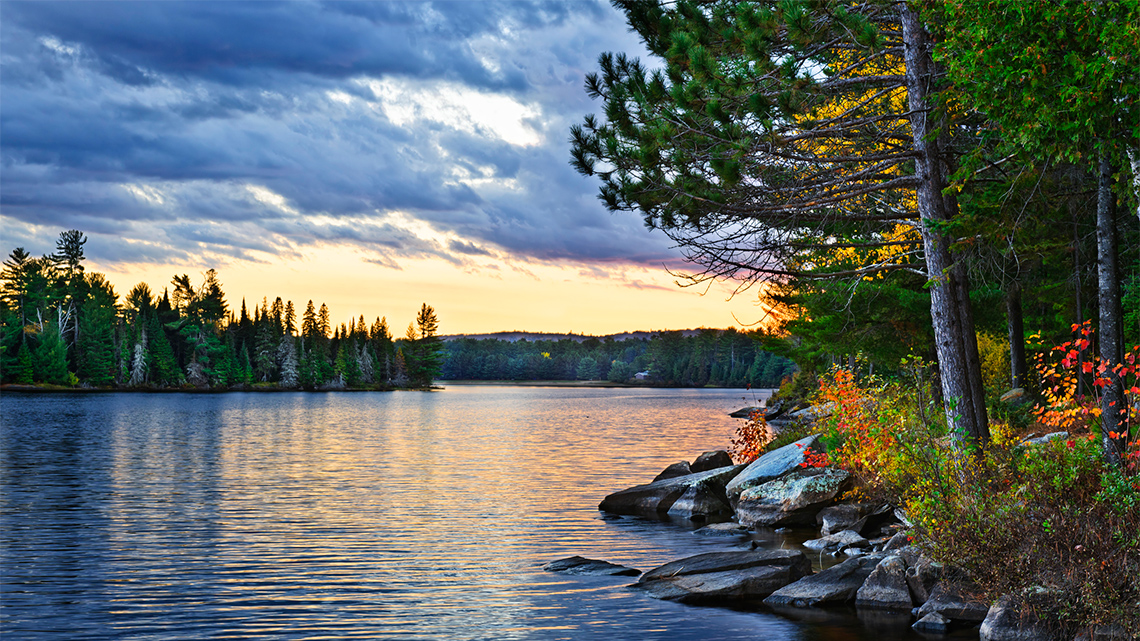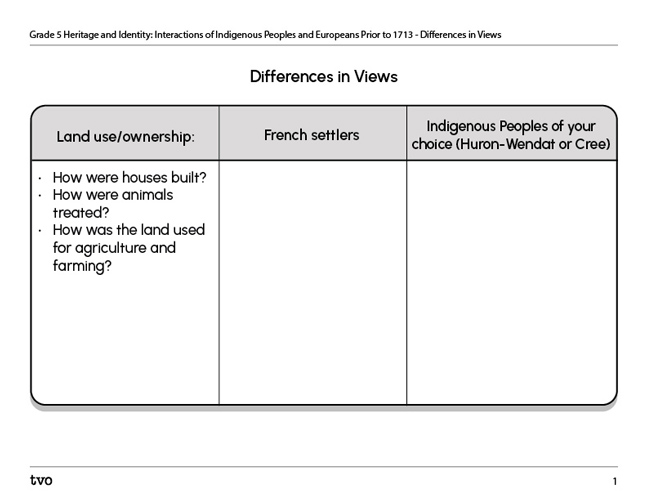Minds On
Communities and their natural resources
There are many different cultures and communities all over the world. Each of these communities have their own different spiritual beliefs, celebrations, ways of governing, views on the environment, traditions, and customs. However, one big difference is how communities respond to natural resources including water, forests, and vegetation.
The importance of water conservation
Explore the following video from TVOK News entitled “Kids Can Change the World.”
In the following video, you will meet Autumn, who is a water conservationist and activist from Wikwemikong First Nation. This means that she speaks about water and the importance of protecting the water. She has spoken to the leaders of the United Nations about the importance of clean drinking water.
Autumn explains very clearly her personal connection to water, her people’s belief and understanding of how sacred water is, and how she is willing to fight for the government of Canada to protect the water and help her people.
Reflection
Now let's pause and reflect on the video with the following question:
How did Autumn’s beliefs influence her understanding of the role of water?
Press the ‘Hint’ button to explore a possible idea.
Action
Comparing Haudenosaunee and French settler perspectives
French settlers from Europe had very different perspectives on the world compared to Indigenous Peoples, already living on the land that is now Canada.
Let’s compare two specific perspectives of the French settlers and the Haudenosaunee, and their perspectives on land use, religion or spiritual beliefs, and ways of governing.
Land use

Press the following tabs to explore each perspective on land use.
Indigenous Peoples lived in harmony with the land and aimed to protect the land for generations to come. One of the ways of doing this is by only taking what is needed from the land and giving back to the land when possible. Similar to other types of relationships, giving back to the land is a way of honouring and showing appreciation. When possible, some actions to give back include planting, recycling, and composting.
Let’s explore the Haudenosaunee as an example. In the 1600s, and today, the Haudenosaunee understood themselves as the protectors of the land. They believed that they borrowed the Earth from their children’s children and that they had a duty to protect the Earth. Corn, squash, and beans were planted, nurtured (taken care of) and harvested by the Haudenosaunee women. Other community members built longhouses, like the one in the image below, which were communal homes that housed multiple families within the same clan.
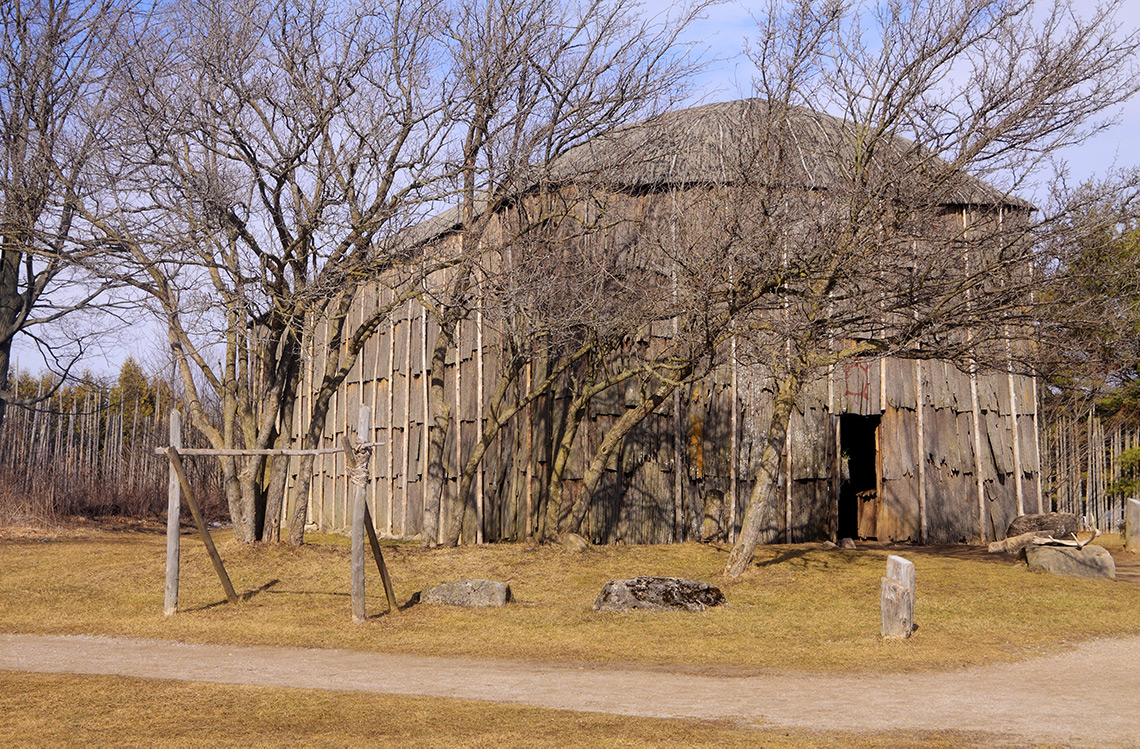
French settlements followed the seigneurial system between 1627 and 1854. The seigneur or lord granted land to each family or habitants in a feudal system. Families produced food for their families and paid a royalty to the seigneur, renting the land or becoming tenants.
The land was divided into rectangular strips of land called rangs (river lots) with access to the river. In the center of the grounds was a mill for grinding grain, which was one of their main crops, and a church. They also grew lentils, peas, beans, onions, asparagus, and melons. The seigneur granted licenses for fishing, woodcutting, and hunting to the habitants. By the 18th century, habitants worked a required number of days annually. In addition to raising children, and performing domestic tasks such as cooking, women worked in the fields with their husbands and helped with the harvest.

The Seigneurial System land distribution shows how land was distributed as a narrow vertical lot with a house on it. Land was divided in the Seigneurial System into rectangle rows next to the river. Each family farmed a different section of the land. The land included a church building, a mill and a strip of common land along the water source.
Brainstorm
Brainstorm
What similar roles did Haudenosaunee and French women share?
Press the ‘Hint’ button to access a possible shared attribute.
Why do you think the land was organized into rows in the seigneur system?
Press the ‘Hint’ button to explore an idea of how the land was organized.
Religious or spiritual views
Indigenous communities
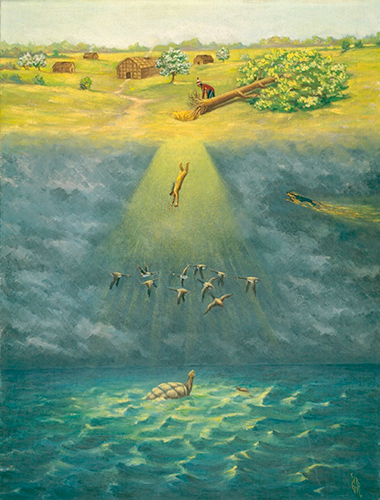
Source: Sky Woman, by Ernest Smith, 1936, Collection of the Rochester Museum and Science Center, Accession # 36.331.1
All Indigenous communities had, and still have today, spiritual beliefs; they follow specific ceremonies based on where they live and their community’s culture. Many Indigenous beliefs centered around the idea that there was a spirit world which included people and all living things. Some of these include plants, animals, and water. Many groups had a leader who was believed to have a special ability to call upon the spirit world when needed.
Most Indigenous communities believed in a Creation Story that talked about the origin of the moon, the sun, the stars, and human beings. These stories also spoke about the environment and its relationship with humans. All Indigenous Peoples understood that they were, and still are, connected to the stars.
French settlers
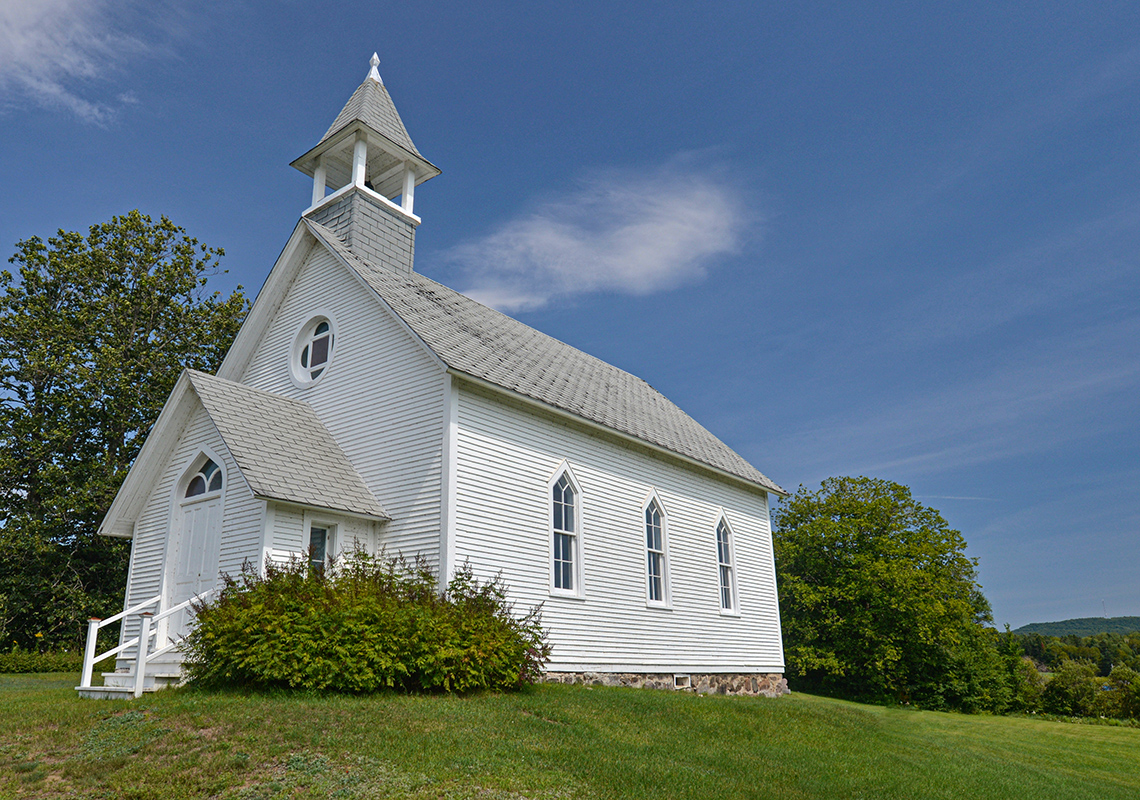
Many Europeans in the 1600s followed the Catholic Faith. They believed their religion was the only faith and they often did not tolerate or understand other belief systems. They believed that God controlled everything and that only humans had souls.
When European settlers arrived in the 1600s, they wanted to make sure Indigenous Peoples would forget their own beliefs. They wanted to make all Indigenous Peoples Christians. They sent missionaries who were called “Jesuits” to live amongst Indigenous Peoples and try to teach them about Christianity. The Jesuits also requested that nuns assist them with Indigenous girls.
Press ‘Missionaries’ to find out the definition for this word.
Review
Now let's review what we just learned with the following questions:
What was one similarity between the Indigenous and European religious and spiritual beliefs shared in this activity?
Press the Hint button to explore a possible answer.
What was a significant way in which these two belief systems were not the same?
Haudenosaunee governance
All Indigenous communities had a type of governance, with leaders that were chosen in different ways. Chiefs and Elders often worked together to make decisions about important community matters.
Each Indigenous governance is slightly different. Let’s explore the Haudenosaunee governance as an example. This Nation still inhabits this land today, but for this activity, we are going to be discussing the communities at the time of early European settlement.
Press the following tabs to explore the key figures of Haudenosaunee governance.
This is a traditional role of elder matriarch women whose duties included appointing chiefs. The Clan Mother watched the male members of the clan and determined their growth, maturity, decision-making ability, and how well they treated and were able to relate to others as part of this process. Traditionally, the Clan Mother was selected according to her age, with the oldest woman in the clan becoming Clan Mother. The Clan Mother was responsible for the overall well-being of the clan and acts as the voice of the community when conversing with the chiefs.
Chiefs were responsible for making decisions for the community. They acted as advisors and counsellors for their community and participated in Haudenosaunee government.
An Elder is an individual who has a deep understanding of their nation’s history, culture, knowledge, ceremonies, and/or traditional teachings. They were recognized by their community and were responsible for making decisions, giving advice on issues, and teaching future generations.
Faithkeepers were the people who worked alongside the Clan Mother and chiefs. Their responsibility was to uphold the traditions and culture of the Haudenosaunee. This may have included preparing for ceremonies and organizing the community for events. They also acted as spiritual advisors for their community.
French government
In New France, the European government system was like a pyramid. At the top of this pyramid was the King of France, Louis XIV, and he had absolute power. The King was responsible for choosing people to help run New France.
Explore some of the important European roles.
Review
After you have explored the key figures of governance in the previous section, complete the following true or false activity.
For each sentence, select the correct answer of true or false from the drop-down menu.
Exploring similarities and differences
Now that we have explored the information in the Action section, identify the similarities and differences between French Settlers and the Haudenosaunee communities with a focus on the environment, religion, and governance.
The following is an example of an organizer. However, you may create a chart using other headings of your choice.
Record your responses for the Similarities and Differences Between French Settlers and the Haudenosaunee Communities activity in your notebook or use the following fillable and printable document. If you would like, you can use speech-to-text or audio recording tools to record your thoughts.
| French settlers | Haudenosaunee communities | |
|---|---|---|
|
Land Use/ Ownership
|
||
| Religious views (Christian God or the Creator) | ||
|
Governance:
|
Press the ‘Activity’ button to access The Similarities and Differences Between French Settlers and Haudenosaunee Communities.
Consolidation
Task 1: Maintaining Indigenous practices
First Nations continue to maintain practices that are geared towards the sustainability of the environment. Explore the following two videos and use a method of your choice, record the ways the girls and their communities are continuing sustainable practices in an organizer.
Check out this video from Raven’s Quest entitled "Madison” to learn more about sustainable practices.
Explore the following video entitled “Hope to learn more about environmental practice.”

Complete the Sustainable Practices of the First Nations activity in your notebook or use the following fillable and printable document.
| First Nations | Sustainable Practices |
|---|---|
Press the ‘Activity’ button to access the Sustainable Practices of the First Nations activity.
Task 2: Lasting Indigenous influences
Let’s consider Indigenous influences on European cultures in Canada.
Explore the following two videos entitled “Indigenous Hand Drum” and “Pow Wow” from It’s My Party to learn about where non-Indigenous young people learn about art, culture, food, and spiritual beliefs and traditions from Indigenous peoples.
Complete the Indigenous Traditions activity in your notebook or use the following fillable and printable document. List the Indigenous traditions that were new information for Emil in It’s My Party and for Monica in Backyard Beats.
| Backyard Beats with Monica | It’s My Party with Emil |
|---|---|
Press the ‘Activity’ button to access Indigenous Traditions.
Reflection
As you read through these descriptions, which sentence best describes how you are feeling about your understanding of this learning activity? Press the button that is beside this sentence.
I feel...
Now, record your ideas using a voice recorder, speech-to-text, or writing tool.
Press ‘Discover More’ to extend your skills.
Discover MoreIdentify the differences between French settlers and either the Huron-Wendat or Cree in terms of views on the land, religion, and governance.
Record your responses in the following Differences in Views activity in your notebook or using the following fillable and printable document. If you would like, you can use speech-to-text or audio recording tools to record your thoughts.


